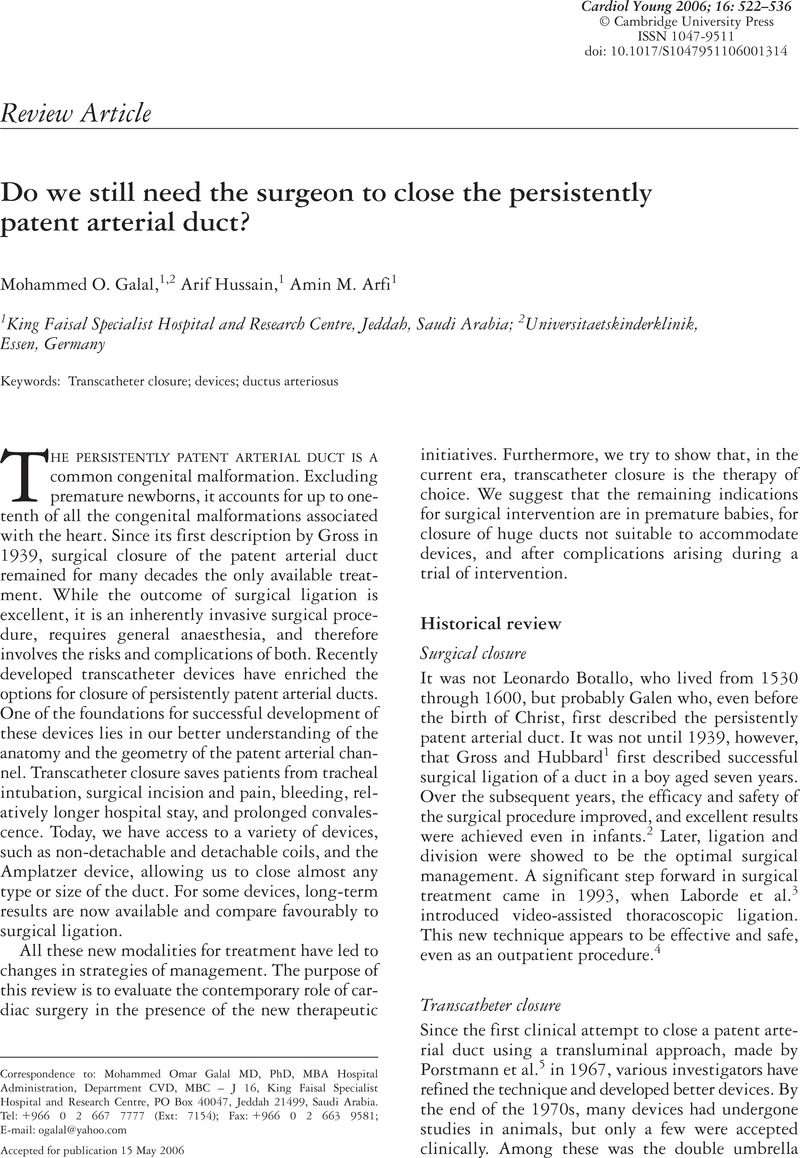Crossref Citations
This article has been cited by the following publications. This list is generated based on data provided by Crossref.
Giroud, Jorge M.
and
Jacobs, Jeffrey P.
2007.
Evolution of strategies for management of the patent arterial duct.
Cardiology in the Young,
Vol. 17,
Issue. S4,
p.
68.
Giroud, Jorge M.
and
Jacobs, Jeffrey
2008.
Re: Evolution of strategies for management of the patent arterial duct.
Cardiology in the Young,
Vol. 18,
Issue. 3,
p.
359.
Abadir, Sylvia
Boudjemline, Younes
Rey, Christian
Petit, Jérome
Sassolas, François
Acar, Philippe
Fraisse, Alain
Dauphin, Claire
Piechaud, Jean-François
Chantepie, Alain
and
Lusson, Jean-René
2009.
Significant persistent ductus arteriosus in infants less or equal to 6 kg: Percutaneous closure or surgery?.
Archives of Cardiovascular Diseases,
Vol. 102,
Issue. 6-7,
p.
533.
Chen, Zhaoyang
Chen, Lianglong
and
Wu, Liming
2009.
Transcatheter Amplatzer Occlusion and Surgical Closure of Patent Ductus Arteriosus: Comparison of Effectiveness and Costs in a Low-Income Country.
Pediatric Cardiology,
Vol. 30,
Issue. 6,
p.
781.
Núñez, Fernando Rueda
Álvarez, Alejandro Ávila
Trisac, José Luis Fernández
and
Pardeiro, César Abelleira
2010.
Cierre percutáneo del ductus arterioso persistente en el neonato prematuro.
Revista Española de Cardiología,
Vol. 63,
Issue. 6,
p.
740.
Benson, Lee N.
2010.
Paediatric Cardiology.
p.
875.
Wang, Jou-Kou
Wu, Mei-Hwan
Lin, Ming-Tai
Chiu, Shuenn-Nan
Chen, Chun-An
and
Chiu, Hsin-Hui
2010.
Transcatheter Closure of Moderate-to-Large Patent Ductus Arteriosus in Infants Using Amplatzer Duct Occluder.
Circulation Journal,
Vol. 74,
Issue. 2,
p.
361.
Núñez, Fernando Rueda
Álvarez, Alejandro Ávila
Fernández Trisac, José Luis
and
Pardeiro, César Abelleira
2010.
Percutaneous Closure of Patent Ductus Arteriosus in Preterm Infants.
Revista Española de Cardiología (English Edition),
Vol. 63,
Issue. 6,
p.
740.
Jung, Jo Won
2011.
Do We Have to Close Residual Patent Ductus Arteriosus After Surgery or Transcatheter Intervention?.
Korean Circulation Journal,
Vol. 41,
Issue. 11,
p.
639.
DRIGHIL, ABDENASSER
AL JUFAN, MANSOUR
AL OMRANE, KHALID
AL ATTA, JAMEEL
AL OMRANI, AHMED
and
AL FADLEY, FADEL
2012.
Safety of Transcatheter Patent Ductus Arteriosus Closure in Small Weight Infants.
Journal of Interventional Cardiology,
Vol. 25,
Issue. 4,
p.
391.
Tao, Kaiyu
Zhu, Da
An, Qi
Liu, Bin
and
Lin, Ke
2012.
Perventricular Device Closure of Patent Ductus Arteriosus: A Secondary Chance.
The Annals of Thoracic Surgery,
Vol. 93,
Issue. 3,
p.
1007.
Elsheikh, Raghda Ghonimy
Darweish, Ahmed Z.
Elsetiha, Mohamed
and
Kamel, Hazem
2014.
Comparative study between real time three dimensional echocardiogram and angiography in evaluation of patent ductus arteriosus, single center experience.
Journal of the Saudi Heart Association,
Vol. 26,
Issue. 4,
p.
204.
Kretschmar, O.
Navarini, S.
and
Knirsch, W.
2015.
Interventionelle Kinderkardiologie.
Monatsschrift Kinderheilkunde,
Vol. 163,
Issue. 1,
p.
69.
LINDINGER, A.
KOZLIK-FELDMANN, R.
and
CESNJEVAR, R.
2015.
Leitlinien Kinder- und Jugendmedizin.
p.
M13.1.
Carmo Mendes, Inês
Heard, Hannah
Peacock, Kelly
Krasemann, Thomas
and
Morgan, Gareth J.
2017.
Echocardiographic Versus Angiographic Assessment of Patent Arterial Duct in Percutaneous Closure: Towards X-ray Free Duct Occlusion?.
Pediatric Cardiology,
Vol. 38,
Issue. 2,
p.
302.
Epçaçan, Serdar
Bulut, Mustafa Orhan
Yücel, İlker Kemal
Ceviz, Naci
and
Çelebi, Ahmet
2019.
Preliminary results of the CeraflexTM PDA occluder and device behaviour during releasing.
Cardiology in the Young,
Vol. 29,
Issue. 4,
p.
519.
El‐Saiedi, Sonia Ali
Elshedoudy, Sahar Abdulla
El‐Sisi, Ammal Mahmoud
Hanna, Baher Matta
Fattouh, Aya Mohammed
and
Hijazi, Ziyad
2020.
Transcatheter closure of residual patent ductus arteriosus.
Catheterization and Cardiovascular Interventions,
Vol. 95,
Issue. 1,
p.
78.
Kidwai, Mohammad Moaaz
Abqari, Shaad
Kamran, Mohammad Mirza
Haseen, Mohammad Azam
Yadav, Mayank
Rabbani, Shamayal
and
Ghazanfar, Md
2023.
Transcatheter Device Closure of Postsurgical Residual Left to Right Shunt Lesions in Children during the Immediate Postoperative Period.
Indian Journal of Clinical Cardiology,
Vol. 4,
Issue. 4,
p.
248.
Steiner, Kristoffer
Sjöberg, Gunnar
Karsenty, Clément
Bianco, Lisa
Bautista‐Rodriguez, Carles
and
Fraisse, Alain
2024.
Mind the gap‐missing device on the shelf? Retrospective experience with 5/7 Occlutech duct Occluder.
Acta Paediatrica,
Vol. 113,
Issue. 4,
p.
812.



